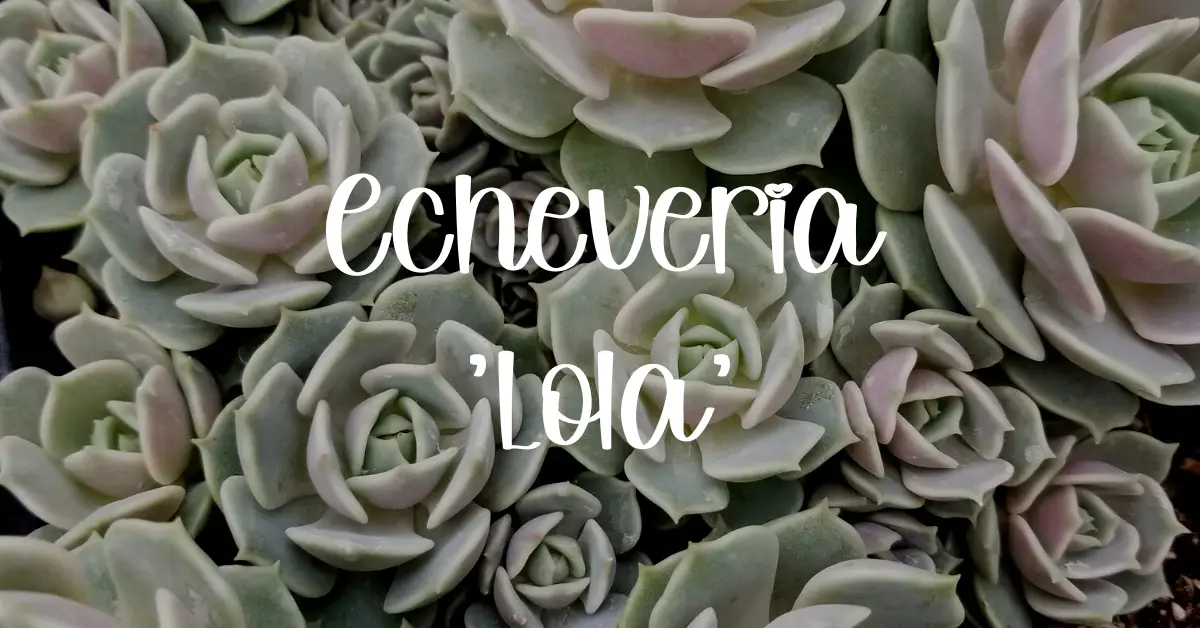
Echeveria ‘Lola’ is a beautiful and low-maintenance cultivar of the Echeveria genus, known for its rosette-forming succulent leaves and bright pink or orange flowers. Bred by the famed Echeveria hybridizer Dick Wright in Fallbrook, California, ‘Lola’ is the result of the cross between Echeveria ‘Tippy’ and E. lilacina. It has a thick layer of farina, a fine, white powder that gives the plant a pearlescent marble-like appearance with rosy undertones.

If you’re looking for a striking and easy-to-care-for plant for your garden or indoor space, Echeveria ‘Lola’ is definitely worth considering. In this article, we’ll cover all the essential information you need to know about ‘Lola’, including its appearance, care requirements, and propagation methods.
Description of Echeveria ‘Lola’
Echeveria ‘Lola’ is a small to medium-sized plant that grows to be 3-5 inches tall, with a rosette size of 5-6 inches. Its plump, teardrop-shaped leaves are a bluish-gray color and are covered in a thick layer of farina. In the summer months, ‘Lola’ produces tall stalks of pink or orange flowers that add a pop of color to the plant.
Care Instructions for Echeveria ‘Lola’
Echeveria ‘Lola’ is relatively easy to care for and is well-suited for growing in a variety of settings. Here are a few tips to keep ‘Lola’ happy and healthy:
Light: Echeveria ‘Lola’ needs bright, indirect light to maintain its compact rosette form and vibrant color. It can tolerate some direct sun, but it’s best to avoid exposing it to intense midday sun to prevent the leaves from getting sunburnt.
Soil: It’s important to plant ‘Lola’ in well-draining soil to prevent rot. A cactus and succulent soil mix with 50% to 70% mineral grit (such as coarse sand, pumice, or perlite) is a good choice. Make sure to choose a pot with drainage holes to allow excess water to drain out.
Water: Echeveria ‘Lola’ is a succulent, so it doesn’t need a lot of water to thrive. Water the plant deeply, allowing the soil to dry out completely before watering again. Overwatering is the most common cause of problems with Echeveria plants, so be sure to let the soil dry out completely before watering again.
Temperature: Echeveria ‘Lola’ is hardy in USDA zones 9-11, but it can also be grown as a houseplant in other regions. If you live in an area with frost, it’s a good idea to bring ‘Lola’ indoors during the colder months to protect it.
Propagation of Echeveria ‘Lola’
Echeveria ‘Lola’ is easy to propagate and can be propagated through stem cuttings or mature leaves, or by separating offsets from the base of the mother plant. It is also known as “Mexican Hens & Chicks,” as it can produce new offsets or “chicks” around the base of the plant. These offsets can be left to form a cluster or transplanted.
If you’re interested in propagating ‘Lola’, here’s a quick overview of the process:
Stem Cuttings: To propagate ‘Lola’ through stem cuttings, simply cut a healthy stem from the plant and remove the lower leaves. Place the stem in a well-draining soil mix and keep it in a warm, bright location. Water the soil lightly and mist the leaves occasionally to keep them from drying out. Within a few weeks, you should see new roots forming. Once the cutting has rooted and established itself, you can transfer it to a larger pot or plant it in the ground.
Definitely check out: How to Water Succulents So They Don’t Die
Offsets: Echeveria ‘Lola’ will often produce offsets, or “chicks,” around the base of the mother plant. These offsets can be left to form a cluster or separated and transplanted into their own pots. To separate the offsets, gently lift the mother plant and carefully remove the offsets using a sharp knife or scissors. Plant the offsets in well-draining soil and water them lightly.
You might like: My Succulent Leaves Are Turning Yellow
Conclusion
Echeveria ‘Lola’ is a stunning and easy-to-care-for plant that is well-suited for a variety of settings. Its rosette-forming leaves and bright pink or orange flowers make it a standout choice for both outdoor gardens and indoor pots. With proper care and the occasional propagation, ‘Lola’ can thrive and bring a touch of beauty to your space for years to come.
Quick question: Should you mist succulents? Find that answer here.
Growing Season:
Summer
Dormant Season:
Winter
Hardy to USDA Zone: 10- Size: Up to 6″ wide
- Foliage: Pale green to white, Pink tips when stressed
- Flower: Pink
Propagation: Stem cuttings, leaves, seed, offsets
Light: Full sun, bright shade
Water: Drench & Dry- Soil: Gritty, mostly inorganic, quickly draining
- Origin: Mexico
About Echeveria ‘Lola’
Echeveria ‘Lola’ is a hybrid of Echeveria ‘Tippy‘ x E. lilacina created by the famous hybridizer, Dick Wright, in 1980.
It is easily one of the most popular succulents and is super common at garden centers everywhere. Mature Echeveria ‘Lola’ plants produce lots of offsets below the lowest set of leaves. Its leave also propagate easily.
The rosettes of Echeveria ‘Lola’ take on a beautiful, almost iridescent color scheme of pastel greens and pinks. Super pretty.





